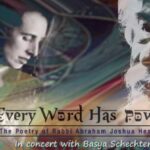Rabbi Jill Jacobs
He offered me an urgency that I hadn't felt in my Judaism before then.
T’ruah: The Rabbinic Call for Human Rights
New York, New York
A Jewish Perspective
Transcribed from an Interview
I first encountered Heschel at Prozdor at Hebrew College in Boston when I was in high school. In Bible class, The Prophets was one of our textbooks. This book wasn’t presented as a treatise from a philosopher who speaks about justice. I remember going through it and being intrigued; I didn’t understand 99 percent of it, but it stuck in my head. At some point in college and rabbinical school, I reread The Prophets, found God in Search of Man and then Moral Grandeur. Then in a class with Neil Gillman (z”l) in my first year of rabbinical school, we spent quite a lot of time with Heschel.
In The Rabbinical School, I was developing an ambition of doing social justice as a rabbi, which was not a thing that people were talking about in the late 1990s, early 2000s. Now it’s completely and totally normal. But at JTS at the time, the response was, “Why don’t you go to law school, social work school, or something else?” When I read Moral Grandeur the first time, it felt like he had said all of the things. Not only did somebody already write what I’ve been looking for, he wrote it better than I could even imagine.
He offered me an urgency that I hadn’t felt in my Judaism before then. I didn’t have models for how Judaism interacted with engagement in the world and with justice work. I grew up in a Conservative congregation and we went to a soup kitchen every Christmas, but social justice wasn’t really built into what we were doing. And it certainly hadn’t been put in theological or Jewish language besides tzedakah, nothing deeper than that. This was extraordinary.
Through books like The Prophets and God in Search of Man, Heschel provided me with the sense that God cares about what's happening here and that what we're doing has an impact on God. For me, Heschel put together that observance and social justice are connected. It is all unified because God cares about what we do. He provided a model of an observant person with a relationship with God, deeply immersed in text, for whom social justice is part of his daily life.
I don’t go to protests on Shabbat. I work six days a week. Shabbat is important to me; it is a check on our hubris. There is a sense that I must work 24 hours a day, because there is an emergency. But the truth is, there is always an emergency. And it’s been an emergency since the world was created. I can check out of my activism for 25 hours each week. God created the world in six days, but the world wasn’t finished. Even if I work that one extra day, there wouldn’t be less work to do the next day.
I aspire to Heschel’s integration between his life as a traditionally religious Jew with a relationship with God and his deep involvement in justice work. There is no division; it is all part of a whole. I see Judaism as an integrated way of living that doesn’t make divisions between my activism and religious practice.
Additional Text:
Stop Looking for the Next Heschel. They Are All Around You (The Forward)

